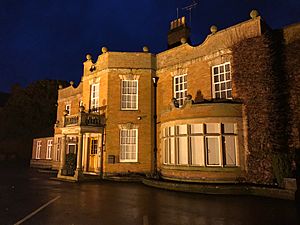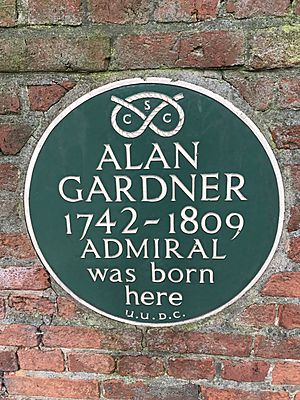Alan Gardner, 1st Baron Gardner facts for kids
Quick facts for kids
The Lord Gardner
|
|
|---|---|

Alan Gardner by William Beechey
|
|
| Born | 12 February 1742 Uttoxeter, England |
| Died | 1 January 1809 (aged 66) |
| Allegiance | |
| Service/ |
|
| Years of service | 1755–1800 |
| Rank | Admiral |
| Commands held | Jamaica Station Leeward Islands Station Cork Station Portsmouth Command |
| Relations | Alan Gardner (eldest son), Robert Barrie (nephew), William Linnæus Gardner (nephew) |
| Other work | MP for Plymouth and, later, Westminster. |
Alan Gardner, 1st Baron Gardner (born February 12, 1742 – died January 1, 1809) was a brave and respected officer in the British Royal Navy. He was known as a very skilled captain of fast ships called frigates. Later in his career, he became a high-ranking admiral. He was also a peer of the realm, which means he held a special title.
Contents
Alan Gardner started his naval journey in 1755. By 1766, he became a captain. His first ship was a 'fireship' called HMS Raven. He then commanded several speedy frigates. After that, he moved on to command larger warships.
Important Commands and Battles
In 1782, Gardner commanded a powerful 98-gun ship called HMS Duke. He led this ship at the Battle of the Saintes. This was a major naval battle.
Later, in 1786, he became a commodore. He was in charge of the Jamaica Station. This group of ships included HMS Europa (1765) and HMS Experiment. His job was to stop illegal trading in the Gulf of Mexico. He also ordered detailed maps to be made of important places in the Caribbean Sea. During this time, he guided and taught future famous explorers. These included George Vancouver, Peter Puget, and Joseph Whidbey.
A Member of Parliament
Gardner also served as a Member of Parliament. He represented Plymouth starting in 1790. Later, in 1796, he represented Westminster. In 1790, he joined the Board of Admiralty. This board helped manage the Royal Navy.
Fighting Scurvy
In 1793, Gardner became commander-in-chief of the Leeward Islands Station. As a rear admiral, he believed that lemons could cure scurvy. Scurvy was a terrible disease that affected sailors. Most doctors at the time disagreed with him. But Gardner insisted on getting lemons for his ships.
His ship, HMS Suffolk, sailed to India without any scurvy outbreaks. This was a huge success! It helped convince the Admiralty. In 1795, they decided to give lemon juice to sailors every day. This simple change greatly reduced scurvy in the navy.
Dealing with Mutiny
Gardner left the Admiralty Board in 1795. He was then promoted to full admiral. In 1797, he commanded a group of ships during the Mutiny at Spithead. This was a time when sailors protested their conditions. Gardner tried to talk with the mutineers. He even got very angry at one point. But in the end, calmer heads helped resolve the situation.
Later Commands and Honors
In 1800, Gardner became commander-in-chief of the Cork Station. That same year, he was given the title of Baron Gardner. This was a special honor in the Peerage of Ireland. In 1806, he received another title, Baron Gardner, in the Peerage of the United Kingdom.
He briefly commanded Portsmouth in 1803. But he soon returned to the Cork Station. In 1807, he became commander-in-chief of the Channel Fleet. He passed away while still in this role on January 1, 1809.
His memorial in Bath Abbey mentions another honor. He was made Major General of the Marine Forces. This was a new position created just for him. It recognized his important role in the Battle of the 1st of June 1794.
Family Life
Alan Gardner was born at the Manor House in Uttoxeter. A special plaque marks his birthplace. He married Susannah Hyde Gale in Kingston, Jamaica on May 20, 1769. Susannah was from a wealthy family in Jamaica. They had nine sons and one daughter.
Many of his children followed in his footsteps. His oldest son, Alan Gardner, 2nd Baron Gardner, also became an admiral in the Royal Navy. His second son, Francis, also became an admiral. His third son, William, became a major general in the army.
Gardner's brother, Major Valentine Gardner, served in America. Gardner's nephew, Colonel William Linnæus Gardner, created a famous Indian cavalry unit called Gardner's Horse.
His sister, Dorothea, had a son named Robert Barrie. With his uncle's help, Robert joined the Vancouver Expedition. Later, Robert Barrie became a knight and a rear admiral.
Legacy
A ship called the Admiral Gardner was named after him. This ship was an East Indiaman, which carried goods for the East India Company. Sadly, it was wrecked in 1809. It was carrying many copper coins for India. These coins were kept in tightly sealed barrels. Many of them were found around 1986. Today, you can sometimes find these "shipwreck coins" for sale.
See Also
- Alan Gardner, 2nd Baron Gardner
- Robert Barrie
- William Linnæus Gardner



